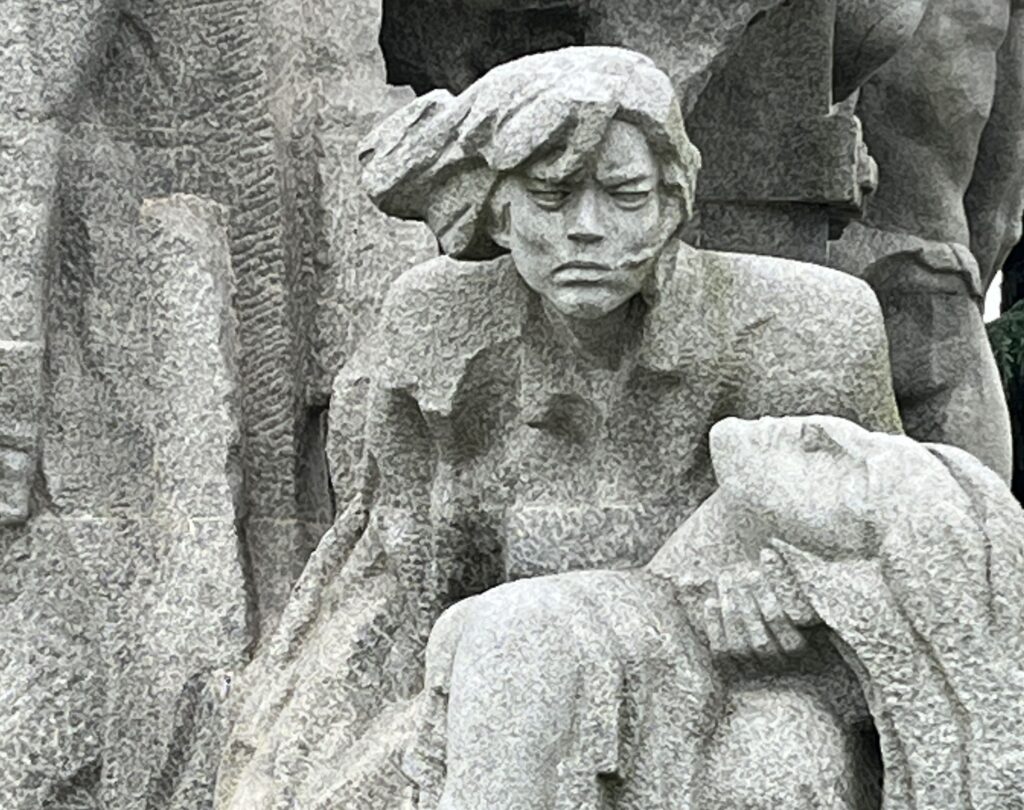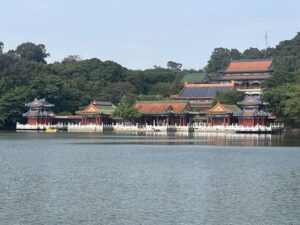The Longhua Martyrs Cemetery | The Official Schoolgirl Milky Crisis Blog


Just around the corner from the tourist-magnet Longhua Temple is one Shanghai’s most exciting museums – a facility dedicated to framing the story of China’s Revolution in terms of its relationship to Shanghai itself, where so many of the fights, protests and strikes that defined it took place.
The Longhua Martyrs Cemetery makes fantastic use of its space and location, built over the site of the former prison and execution ground where so many Communist martyrs were created. The site has, at some point, been both a holding area for the Nationalist Kuomintang government and a detention centre for the Japanese invaders in World War Two. Twin walls, carved with the names of victims of the Kuomintang, snake around the gardens, leading off from the main entranceway, which is dominated by chunky statues not of individual revolutionaries, but of the spirit of Revolution itself, represented not only by soldiers, but by nurses and mothers, students and musicians.

The museum itself tracks the rise of the People’s Republic of China through its early stops and starts, including relative obscurities such as the Rebellion of the Small Swords Society, in which part of Shanghai turned into a Triad enclave, mysteriously joined by European supporters, or the activities of the Su Bao (Jiangsu Daily), a newspaper shut down by the imperial authorities in 1903 for daring to question the rule of the Emperor. The story of the Su Bao is told through the life of its star writer Zou Rong, whose pamphlet The Revolutionary Army was the cause of the newspaper’s downfall. Zou himself died in prison in 1905 and was awarded a posthumous general’s rank by Sun Yat-sen. He is depicted here in a lush oil painting, as a “Soldier of the Revolutionary Army”, wielding a pen instead of a sword.

Zou’s story is only the first of dozens of vignettes that anchor the stories of China’s revolutionaries in context and commemoration. There are dioramas and relics, photographs and statues, video-on-demand testimony and even a looped ballet video, each telling the story of a particular individual’s role in lifting China out of its “Century of Humiliation.” It was a humbling and immersive experience, easily one of the best museums I have visited in China, on a par with Changchun’s Museum of the War of Chinese People’s Resistance Against Japanese Aggression.

I soon ran into the exhibit on Zhang Tailei, whose statue so struck me in the pantheon of revolutionaries outside Guangzhou Martyr’s Park last December, but also many other similar incidents in which “failed” protests helped China’s revolutionary movements gain momentum and popular support. One absolutely massive widescreen oil painting celebrates the May 30th Movement, a series of protests and strikes in Shanghai that led to the “Shanghai Massacre” of 1925, in which nine protestors on Nanjing Road were shot and killed by members of the Municipal Police.

I was particularly taken with the works of the artist Chen Jian, who has supplied a series of tableaux for the museum, some of them about specified individual subjects, others about more general themes. Chen’s work includes a moody, cramped depiction of Communists studying in their prison cell, and the beautifully modernist “The Arrestee”, in which two plainclothes police officers lead an unrepentant Communist to a prison van. The picture is suffused with an unsettling physicality, as one of the officers seems to be leaning into his task, as if he is having to bodily drag a prisoner who stands confident with the gravity of being on the right side of history.

Other artists tackle the problematic history of the Longhua Cemetery as the location of White Terror firing squads, such as Wang Shaolun’s “On the Execution Field”, in which a diverse collection of Chinese subjects wait glumly for their imminent deaths.

In one of the most moving exhibits, the museum relates the story of Cai Bozhen and Wu Zhongwen, who were married in the prison van that took them to their deaths, a soaringly romantic revolutionary story that has already been immortalised in a movie, for which extra drama was piled on with “The Internationale” substituting for the Wedding March.

Revolution, for the museum, is a state of grace towards which China groped during its Century of Humiliation, and then fought to maintain in the years that followed. There would be scope here, in a truly comprehensive installation, for an entire extra gallery about the Chinese who lost their lives in some of wrong-turns of the subsequent Chinese state, like the Great Leap Forward and the Cultural Revolution, but such discussions are characteristically muted.
Instead, it favours the idea of revolutionary spirit as something that burned in the hearts of the characters whose stories are told in the exhibits, and should be nurtured and encouraged in everyone. Pointing out that it presumably also flourished in at least some of the millions of people who were starved, beaten or executed during Maoist purges and social experiments in the 1950s and 1960s would ruin the brilliantly told story of a past that marches ever onwards towards a utopian present.

Nor does the museum have much time or space for those revolutionaries who were inconveniently Nationalist. The Nationalist authorities, with whom the Communists themselves fought from 1911 to 1949 (and technically still fight today on Taiwan), might equally lay claim to be the inheritors of the Small Swords Society or the Su Bao, but their contribution is downplayed here. That, perhaps, is only to be expected in Shanghai of all places, where Chiang Kai-shek authorised vicious putsches against Communists, many victims of which died on these very premises.

Instead, the museum’s narrative of the martyrs of the Revolution continues into the 1950s and beyond, with tales of derring-do on numerous Cold War battlefields, and selfless sacrifices by soldiers, firemen and other public servants.

The visitor is guided out past one final giant oil painting, “The Vision” by Li Peng, which looks down on the contemporary Pudong cityscape from a vantage point somewhere high above the Bund. This, it seems to say, is what you now have, because of their sacrifices.
As the visitor heads towards the exit, past the classrooms and library, there is one final exhibit. The museum doesn’t have anything so gauche as a gift shop, but it does have a wall of free bookmarks, filed chronologically. Each bears the image and description of a Martyr of the Revolution, encouraging the visitor to take a piece of Revolution home with them. I couldn’t find any of my newfound favourites on the day, so I settled for Qiu Jin.

The Longhua Martyrs Cemetery and its attendant museum are gold-star examples of the new “Red Tourism”, and an absolutely fascinating example of “the story people tell themselves about themselves.” It is easily the most interesting place I have visited in Shanghai, not least because it finds a way to put Shanghai itself front and centre in the story of the birth of modern China.
Jonathan Clements is the author of A Brief History of China.







